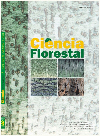
|
Ciência Florestal
Centro de Pesquisas Florestais - CEPEF, Departamento de Ciências Florestais - DCFL, Programa de Pós Graduação em Engenharia Florestal - PPGEF
ISSN: 0103-9954
EISSN: 0103-9954
Vol. 21, No. 4, 2011, pp. 663-675
|
 Bioline Code: cf11065
Bioline Code: cf11065
Full paper language: Portuguese
Document type: Research Article
Document available free of charge
|
|
|
Ciência Florestal, Vol. 21, No. 4, 2011, pp. 663-675
| en |
TREE COMMUNITY OF A PERMANENT FLOODED FOREST AND ITS ADJACENT VEGETATION AREA IN OURO PRETO, MINAS GERAIS STATE, BRAZIL
Pedreira, Gabriel & de Sousa, Hildeberto Caldas
Abstract
The present study aimed to raise the floristic composition and the phytosociological structure of the tree community of an permanent flooded swamp forest known as 'Floresta Padulosa' as well as its adjacent vegetation (semi-deciduous seasonal forest 'Alto Montana') in Itacolomi State Park, Ouro Preto and Mariana, Minas Gerais State, Brazil. The study site is located at an altitude of 1,350m, and the regional climate is classified as Cwb by Köppen's system, with average annual rainfall varying from 1.100mm to 1.800mm and the average annual temperature from 17.4 ºC to 19.8 ºC. In order to make the phytosociological survey 14 plots (10m X 30m) were located, seven in each physiognomy, and all individuals with a minimum CBH (Circunference at Breast Height) of 15cm were sampled. A total of 1136 individuals were sampled, belonging to 24 families, 37 genders and 53 species. The families with higher richness values were Myrtaceae (11), Melastomataceae (5) and Annonaceae, Fabaceae and Rubiaceae (3). The similarity among the studied fragments can be considered lower than expected, showing the existence of individual phytogeographic units, with distinct floristic characteristics. The influence of the adjacent vegetation on the swamp forest may be the most important factor in its floristic differentiation if compared to other swamps areas of Brazil.
Keywords
Swamp forest; Semi-deciduous seasonal forest 'Alto Montana'; Structural and Floristic Analyses
|
| |
| pt |
COMUNIDADE ARBÓREA DE UMA MANCHA FLORESTAL PERMANENTEMENTE ALAGADA E DE SUA VEGETAÇÃO ADJACENTE EM OURO PRETO-MG, BRASIL
Pedreira, Gabriel & de Sousa, Hildeberto Caldas
Resumo
A presente investigação teve como objetivo levantar a composição florística e a estrutura fitossociológica da comunidade arbórea de uma mancha florestal permanentemente alagada, também conhecida como Floresta Paludosa, e de sua vegetação adjacente (Floresta Estacional Semidecidual Alto Montana) localizada no Parque Estadual do Itacolomi, Ouro Preto e Mariana, estado de Minas Gerais. O trecho estudado encontra-se a 1.350m de altitude, sendo o tipo climático ocorrente na região o Cwb, conforme a classificação de Köeppen, com pluviosidade média anual variando de 1.100mm a 1.800mm e temperatura média anual de 17,4 ºC a 19,8 ºC. Para o levantamento fitossociológico foram alocadas quatorze parcelas (10m x 30m), sendo sete em cada fisionomia, nas quais foram amostrados todos os indivíduos com CAP (circunferência a altura do peito) ≥ 15cm. Foram amostrados 1.136 indivíduos distribuídos em 24 famílias, 37 gêneros e 53 espécies. As famílias com maior riqueza foram Myrtaceae (11), Melastomataceae (5) e Annonaceae, Asteraceae, Fabaceae e Rubiaceae (3). A similaridade entre os fragmentos pode ser considerada relativamente baixa e menor do que o esperado, revelando a existência de unidades fitogeográficas individualizadas com características florísticas distintas. A influência diferencial da formação adjacente sob a vegetação paludícola pode ser o fator mais importante na diferenciação florística deste fragmento florestal em relação às diversas áreas florestais alagadas montanas no Brasil.
Palavras-chave
Floresta Paludosa; Floresta Estacional Semidecidual Alto Montana; Análise Estrutural e Florística
|
| |
© Copyright 2011 - Ciência Florestal
Alternative site location: http://cascavel.ufsm.br/revistas/ojs-2.2.2/index.php/cienciaflorestal/index
|
|
